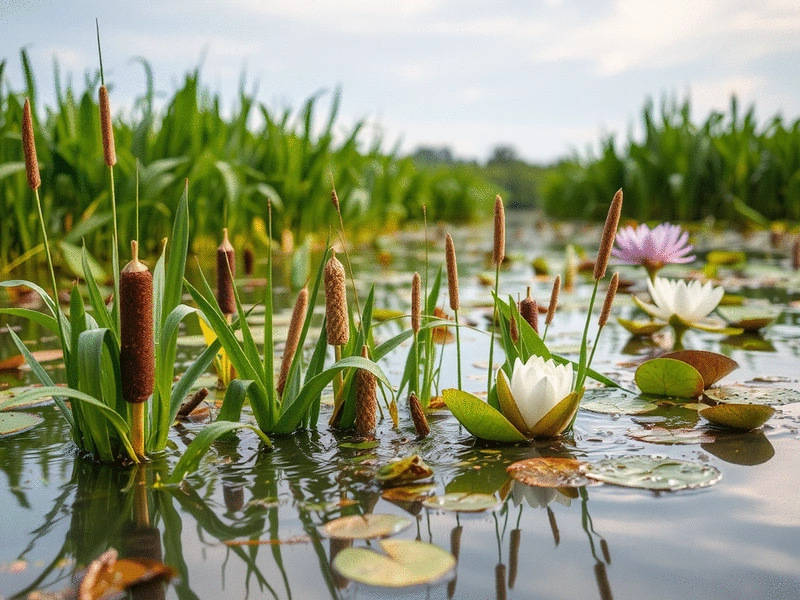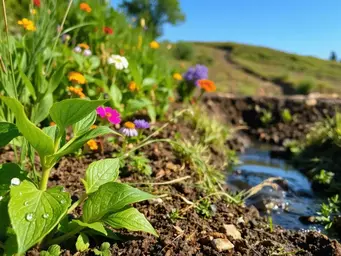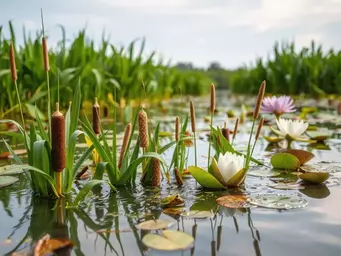Adaptation & Resilience
Native plants are naturally suited to local conditions (soil, water, climate), enabling them to withstand environmental stresses like drought and flooding.
Have you ever considered the profound impact that native plants can have on wetland ecosystems? These unsung heroes not only beautify our landscapes but also play a crucial role in restoring and maintaining the delicate balance of biodiversity.
Native plant selection is fundamental to effective wetland restoration. The success of these efforts hinges on several critical aspects, from ecological adaptation to community involvement, all working together to build resilient ecosystems.
Native plants are naturally suited to local conditions (soil, water, climate), enabling them to withstand environmental stresses like drought and flooding.
Diverse native flora supports complex food webs, providing habitat, food, and fostering ecological interactions from pollination to seed dispersal.
Non-native species outcompete natives, disrupt habitats, and incur significant economic costs for management, reducing overall wetland health.
Involving local communities in planting days and workshops fosters a sense of ownership and promotes long-term environmental stewardship.
When it comes to wetland restoration, native plant selection is crucial. These plants are not just pretty additions; they serve essential roles in maintaining the health and functionality of wetland ecosystems. By choosing native species, we ensure that our restoration efforts align with the natural processes that have shaped these environments over millennia.
In my experience as an environmental scientist, I’ve seen firsthand how native plants contribute to ecosystem resilience. They help to establish a robust foundation for wildlife and support intricate food webs, making them integral to the survival of numerous species. So, why do native plants matter so much? Let’s delve into the reasons.
Native plants are specially adapted to their local environments, making them better suited for wetland conditions. They provide food and shelter for local wildlife, create habitat for pollinators, and contribute to overall biodiversity. Here are a few reasons why these plants are essential:
By prioritizing native species, we can effectively restore damaged ecosystems and enhance their natural beauty. This not only aids in environmental recovery but also promotes sustainability in the long run.
Biodiversity forms the backbone of any healthy ecosystem. A diverse array of native plants ensures that various species can thrive, creating interdependent relationships that enhance ecosystem stability. This biodiversity serves as a buffer against environmental changes and disturbances.
Incorporating a wide range of native species helps to maintain balance within wetland ecosystems. Here are some key points to consider about biodiversity:
As we work on our restoration projects, it’s imperative to keep biodiversity at the forefront of our plant selection strategies. This not only helps to sustain the habitat but also enriches our local environments.
Invasive species pose a significant threat to the health of wetlands. These non-native plants can outcompete native species for resources, leading to reduced biodiversity and altered ecosystem functions. Understanding the impact of invasives is critical for effective restoration. For comprehensive information on wetland assessment and management, consider resources from the EPA.
Here are some key impacts of invasive species:
By being aware of the threats posed by invasive species, we can make informed decisions in our restoration planning. This vigilance will help ensure the long-term success of our wetland projects and the preservation of our precious ecosystems.
As we explore the critical role of native plants in wetland restoration, we'd love to know your thoughts. What challenges have you faced in selecting native species for restoration projects? Share your insights or experiences below:
A: Native plants are crucial because they are adapted to local conditions, providing essential habitats, food sources, and ecological stability. They contribute to resilience against environmental stresses and support complex food webs.
A: A diverse array of native plants fosters varied ecological interactions, supports a more complex food web, and makes ecosystems more resilient to disturbances and invasive species, thus enhancing overall stability.
A: Invasive species outcompete native plants for resources, disrupt natural habitats, reduce biodiversity, and can incur significant economic costs for their management and removal.
A: Engaging local communities through planting days, workshops, and educational programs fosters a sense of ownership, promotes long-term environmental stewardship, and increases the overall effectiveness and sustainability of restoration efforts.
A: Valuable resources include local conservation groups, native plant nurseries (which often offer workshops), and online webinars from environmental organizations. For more guidance on native plant gardening, the USDA Forest Service provides excellent information.
As we reflect on the vital role of native plant selection in wetland restoration, it's clear that the benefits are manifold. From enhancing biodiversity to improving water quality, the integration of native species is crucial for restoring these precious ecosystems. By employing practical strategies that focus on local conditions and community involvement, we can pave the way for successful restoration projects that truly make a difference.
Here’s a recap of the key benefits and practical strategies we've discussed:
These strategies, coupled with a thorough understanding of site-specific conditions, create a solid foundation for wetland restoration initiatives. The effectiveness of these projects often hinges on the collaboration between local stakeholders and environmental organizations, emphasizing the need for a collective approach.
To dive deeper into the art of native plant selection, there are several resources available that can enhance your knowledge and foster meaningful connections within your community. Here are a few recommendations:
By leveraging these resources, you can empower yourself and others to make informed decisions about plant selection and restoration practices. At Wetland Restoration, we are committed to providing ongoing educational materials to support your journey toward effective habitat restoration.
One of the most impactful ways to foster sustainable practices in wetland restoration is through community engagement. When individuals come together with a shared purpose, the outcome can be transformative. Here’s how we can promote environmental stewardship:
As we engage the community, we cultivate a culture of stewardship where everyone feels invested in the health of our wetlands. Remember, every small action contributes to the larger goal of protecting and restoring our vital ecosystems!
Here is a quick recap of the important points discussed in the article:

 In navigating the world of wetland restoration, understanding the financial landscape is paramount.
In navigating the world of wetland restoration, understanding the financial landscape is paramount.
 Did you know that native plants play a crucial role in enhancing water quality and stabilizing soil?
Did you know that native plants play a crucial role in enhancing water quality and stabilizing soil?
 Have you ever considered the profound impact that native plants can have on wetland ecosystems? Thes
Have you ever considered the profound impact that native plants can have on wetland ecosystems? Thes
 What would happen if our wetlands disappeared? The loss of these critical ecosystems could lead to d
What would happen if our wetlands disappeared? The loss of these critical ecosystems could lead to d